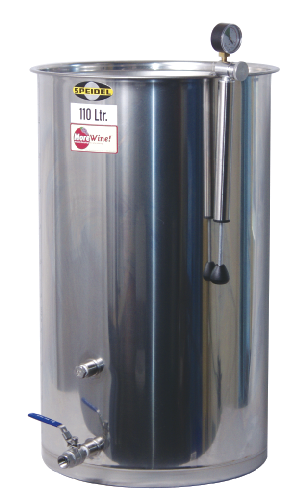
I have counted over fifty glass containers in my home winery! Shapes and sizes range from one-gallon (4-liter) jugs to 5-gallon (19-liter) carboys and 14-gallon (54-liter) demijohns.
This huge collection of containers allows me some flexibility in the amount of wine I make, in vinifying free- and press-run wines separately and in making sure all containers are topped up properly. But they also take up a lot of storage space, require considerable time and effort to clean and sanitize and are prone to breakage. The solution? Floating-lid stainless-steel tanks — probably one of the greatest inventions since the demijohn. The floating-lid design transforms these tanks into variable-capacity containers for fermentation as well as short- and long-term wine storage. The lid is simply inserted inside the tank and then allowed to float on the wine surface. A membrane around the lid is inflated to create an airtight seal.
These tanks are made from stainless steel, which is inert, so wine will not react with it during prolonged aging. And they are easy to clean and store. If your home winemaking hobby has grown from wine kits to 100 gallons (380 liters) or more of wine per year, you should consider investing in floating-lid stainless-steel tanks.
ANATOMY OF A TANK:
A floating-lid stainless-steel tank consists of a fixed-volume tank, which may be equipped with a man door, a sight glass and a three-legged stand, various spigots or valves and a lid with an inflatable membrane. The lid comes with an air pump attachment for inflating the membrane.
Tanks are available in volumes ranging from 9 gallons (34 liters) to 489 gallons (1,850 liters) or more, and different steel thickness (gauge) ranging from 3/128 inch (0.6 mm) to 3/64 inch (1.2 mm). If you intend to run a small winery, you can find tanks up to 1,058 gallons (4,000 liters). That’s a lot of wine!
The lower-gauge steel tanks are more prone to dents. Opt for the higher-gauge tanks, depending on the size you choose and on your budget. Both gauges are commonly available in a metal alloy referred to as AISI 304. This alloy is more susceptible to pitting from SO2 than the AISI 316 alloy that offers a higher degree of resistance to SO2, salts and strong, corrosive acids. AISI 316 tanks are usually found in commercial wineries, whereas nearly all tanks for home winemaking are AISI 304.
You have a choice of bright, mirror or marbled-exterior finish as well as flat, conical or five-percent sloped bottom. The exterior finish is a matter of personal preference, while the conical and sloped bottoms simplify drainage of sediment or liquid if the tank is equipped with a bottom valve.
Tanks are fitted with a spigot (ball valve) ranging from a half inch to 1-1/4 inches, which makes winemaking operations, such as racking and filtering, very simple. Larger-volume tanks also have a discharge valve at the bottom. Some tank types and sizes are equipped with a 12-inch man door on the side of the tank near the bottom for easy-access cleaning and removal of grape solids. A sight glass will also prove useful to determine and monitor the volume of wine in the tank — otherwise it’s guesswork.
The sight glass may be equipped with a sample valve for quickly withdrawing a small amount of wine for tasting. The sample valve can also be located on the main body of the tank. The sample valve is a handy feature and eliminates the need to remove and replace the lid when sampling.
Carefully choose the location where you will be storing the tank since you will not be able to move it once it is filled with wine. A 53-gallon (200-liter) tank full of wine weighs over 500 pounds (227 kg)!
The lid is the “heart” of the tank and is what transforms it into a variable-capacity container. Also made of stainless steel, it is equipped with an inflatable membrane on its circumference. The lid is placed inside the tank, on top of the wine, and allowed to float. The membrane is then inflated using the supplied hand air pump. The membrane creates a perfect seal on the inner circumference of the tank to protect the wine from air.
A special fermentation lock on the lid allows CO2 gas to escape but prevents air from entering the tank. This clever contraption, unlike the well-known fermentation lock, uses two marbles to accomplish this.
The hand air pump is connected to the membrane via a polyethylene tube. A pressure gauge indicates the membrane pressure, which can be adjusted at any time to maintain an airtight seal. The pump has a release valve to deflate the membrane when the lid is to be removed. Be sure to observe the manufacturer’s recommended maximum air pressure in the membrane to avoid damaging it. Some retailers suggest purchasing an extra membrane … just in case.
Given that tanks are very deep, a cord attachment is used for raising or lowering the lid. The larger volume tanks — over 529 gallons (2,000 liters) — have a lid hoisting attachment fixed to the side of the tank. The design makes the raising-lowering operations cumbersome, but a newer, better-designed lid model is now available to keep the lid balanced.
CARING FOR TANKS:
Stainless-steel tanks should always be cleaned and sanitized properly before use. Remember, do not use sulfite or bleaching products on stainless steel! These products will pit the surface of the tank and will shorten its life.
The recommended method for cleaning and sanitizing tanks is a hot-water rinse of the entire inside surface, followed by a sodium percarbonate or sodium carbonate (soda ash) treatment, followed by a citric acid treatment. For the citric acid treatment, dissolve 3 tablespoons per gallon (4 liters) of water. Use just enough solution to properly rinse the entire inside surface of the tank, then complete the sanitization process with a thorough water rinse. Refer to “Keep it Clean” in the Summer 2001 for recommended concentrations of sodium percarbonate and other sanitizing options.
Be sure to clean the lid, spigots, valves, man door and any other parts that will come in contact with the wine. Disassemble the fermentation lock from the lid to remove any spoilage organisms that could be trapped under the gasket. Likewise, remove the spigots and clean the valve components thoroughly. Do this with the valve in the open position and closed position.
When all surfaces and components have been thoroughly cleaned, they can be re-assembled and the wine can then be transferred to the tank. When assembling the spigots and fermentation lock, remember to re-install the gaskets to avoid oxidizing your wine during storage. A leaky spigot will cause the wine to spoil!
Fill the tank partially with water and let it sit overnight to test for any dripping from the spigot. If there is any leakage, the spigot needs to be tightened. Don’t let the water sit in the tank for more than 12 hours. One last hot-water rinse is also recommended.
USING TANKS:
Floating-lid stainless-steel tanks can be used for many different winemaking processes, including fermentation, racking, bulk storage, filtering and bottling. As with glass containers, wine can be stored in tanks for extended durations. The level of free SO2 will need to be monitored and adjusted on a regular basis — the same as you would for wine stored in glass containers (see “Solving the Sulfite Puzzle,” Winter 2000). If some wine must be withdrawn or needs to be transferred or racked to another container, be sure to re-position the lid at the new level inside the tank. Commercial wineries use argon, an inert gas that protects wine from air, to fill the headspace when the lid is not re-positioned. This is an excellent option if you happen to have access to argon gas.
Spigot adapters can be fitted to attach polyethylene tubing of varying diameters ranging from 1/4 to 1 inch or more. The tubing can then be easily connected to a filtering system or a bottling apparatus. By positioning the tank at 2 feet or higher above ground level, wine displacement by gravity greatly simplifies these operations. Cumbersome priming of filtering pumps — self-priming pumps do not require this — and drawing wine from bottling equipment are now simple tasks. Deflate the membrane using the release valve on the pump to maximize flow rate of the wine. Be sure to always vent the fermentation lock before drawing wine out from the tank; otherwise, it will implode.
When inflating the lid, the downward pressure can cause an appreciable amount of wine to pour out from the fermentation trap. To avoid this, inflate the membrane only partially until you are able to pull up the lid without it falling back down. Lift the lid a little, an inch or so, and then pump the membrane up to the recommended pressure. With a bit of experience, you will be able to accomplish this without any substantial wine loss or any air above the wine level.
CHOOSING A TANK SIZE:
When deciding what size of tank you need, assess your current versus future winemaking needs, how many types and styles of wine you will be making concurrently and how long you intend to store wine in bulk and your budget. Prices will vary from less than U.S. $180 for a basic 9-gallon (34-liter) tank to more than U.S. $2,000 for a 489-gallon (1,850-liter) tank. The 53- or 79-gallon (200- or 300-liter) tanks are a good compromise between size and cost. For example, the 53-gallon tank measures approximately 35 inches (90 cm) in height with a diameter of approximately 21 inches (53 cm), and costs around U.S. $375. Fixed-size capacity tanks are also available. These tanks are meant for larger-volume productions. The important difference is they must be filled to capacity.
The most popular floating-lid tanks are made in Italy. Many North American retailers sell them, but given the plethora of sizes, types and options, they cannot carry a large inventory. Instead, they often pre-order on a yearly basis according to customer demand. Pre-orders are accepted until late winter and then shipped to North America in the summer. If you miss this cycle, you may not be able to order until the following year.
If you did not pre-order, you can contact suppliers to ask about availability. If your local retailer or mail-order source does not carry the tanks, ask if their wholesaler can order one for you. Or try other retailers who may carry inventory year round, although they may have a smaller selection of sizes and options.





